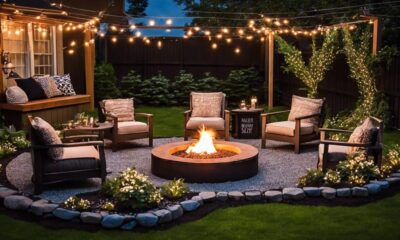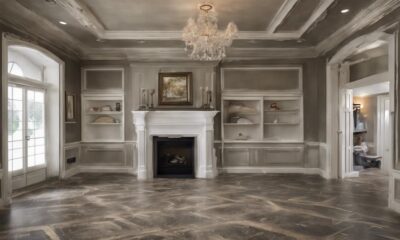Architecture Home Styles
Make My House Look Less Flat: 10 Easy DIY Tricks
Liven up your living space with 10 simple DIY tricks that will transform your flat walls into stylish and vibrant focal points.
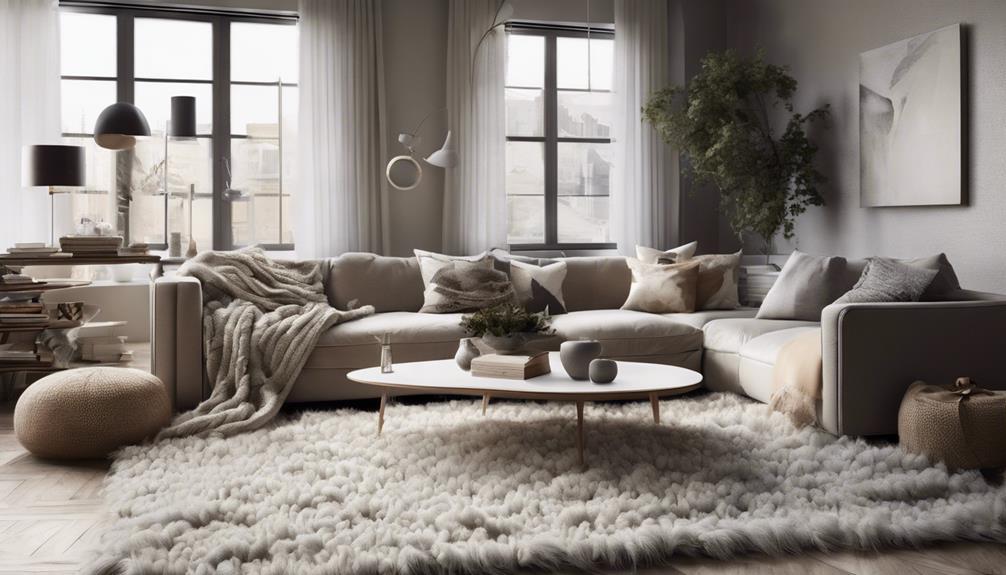
Let's face it, we've all been guilty of staring blankly at our walls, wondering why our living space lacks that certain je ne sais quoi.
But fear not, for there are simple yet effective DIY tricks that can breathe life into your flat surroundings. From easy wallpaper accents to strategic lighting upgrades, these 10 tips are the secret ingredients to adding depth and character to your home.
So, if you're craving a touch of sophistication and flair, stay tuned to discover how a few tweaks can make a world of difference in your living space.
Key Takeaways
- Wallpaper accents and decorative wall paneling add depth and style to walls.
- Cabinet hardware upgrades and frame style selections elevate the overall aesthetic.
- Brighten and expand space with mirrors and modern light fixtures.
- Incorporate DIY floating shelves and indoor plants for texture and decor enhancement.
Add Dimension With Wallpaper Accents
Adding wallpaper accents to your walls can instantly elevate the visual appeal of any room by introducing depth and dimension. Wallpaper has the power to transform flat surfaces into dynamic focal points. By selecting textures, patterns, or metallic finishes, you can enhance the illusion of depth within the space.
The strategic placement of wallpaper accents can break up large, monotonous areas, creating visual interest and a sense of movement. Whether you opt for a bold, eye-catching design or a subtle, sophisticated pattern, wallpaper accents offer a versatile and cost-effective solution to revamp your living environment.
They allow for a customizable approach, enabling you to tailor the look of specific areas according to your taste and style preferences. Embracing wallpaper accents is a creative way to infuse personality and character into your home decor, making it a standout feature that showcases your innovative flair for design.
Update Cabinet Hardware
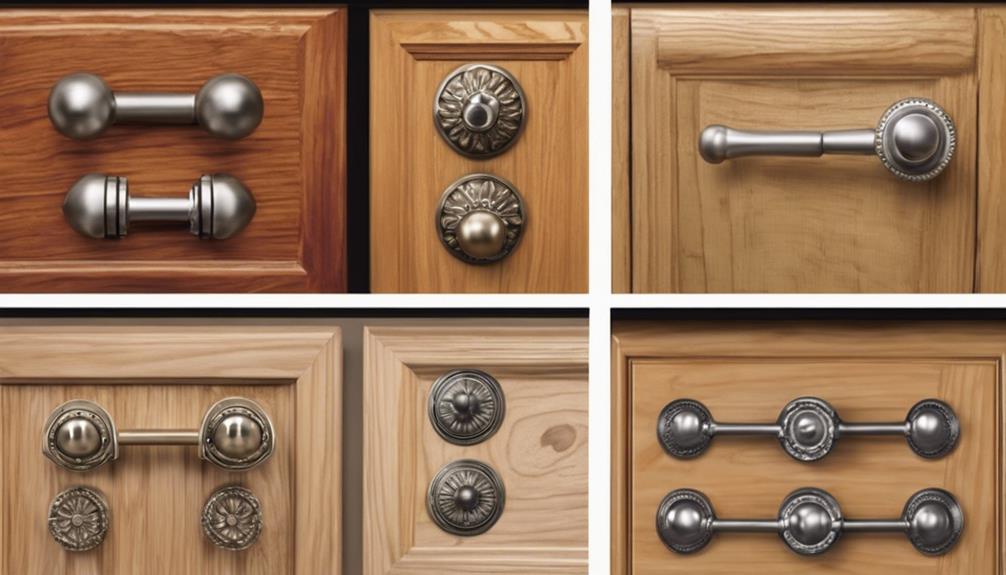
Let's elevate our cabinets by selecting chic knobs and considering sleek modern pulls.
The hardware we choose can instantly transform the look of our kitchen or bathroom, adding a touch of sophistication and style.
With a quick update like this, we can easily enhance the overall aesthetic of our home.
Choose Stylish Knobs
Enhancing your space with chic and distinctive cabinet knobs can effortlessly elevate the style and ambiance of your kitchen or furniture.
When choosing stylish knobs, consider the following:
- Crystal Clear Elegance: Opt for crystal knobs that catch the light and exude luxury.
- Vintage Charm: Choose antique brass knobs for a touch of old-world charm and sophistication.
- Sleek and Modern: Go for sleek, minimalist knobs in brushed nickel for a contemporary look.
- Nature's Beauty: Select wooden knobs with intricate designs to bring a natural and rustic feel to your space.
Consider Modern Pulls
To effortlessly modernize your space and add a touch of contemporary elegance, considering updating your cabinet hardware with sleek and stylish modern pulls can make a significant difference.
Modern pulls have the power to instantly transform the look of cabinets and drawers, breathing new life into any flat-front house. Opting for sleek and contemporary pulls is a cost-effective way to refresh the space, offering a modern touch that complements various decor styles.
With finishes like chrome, brass, or matte black, modern pulls provide versatility in matching your existing aesthetic. By swapping out old hardware for these modern alternatives, you can achieve a cohesive and stylish look throughout your home, elevating its overall appeal with a simple yet impactful change.
Install Decorative Wall Paneling
Let's talk about how decorative wall paneling can bring life to your flat walls.
From adding depth to creating a stylish statement, paneling offers a range of design options to suit your taste.
With some basic tools and a weekend, you can easily elevate your space with custom paneling installations.
Paneling for Added Depth
With a few tools and a touch of creativity, transforming your flat walls into dynamic focal points can be as simple as installing decorative wall paneling.
- Elevate with Elegance: Opt for classic beadboard paneling to add a touch of timeless sophistication to your space.
- Geometric Glamour: Experiment with modern geometric patterns for a contemporary and chic look that draws the eye.
- Contrast and Complement: Paint your paneling in contrasting hues to make a bold statement or choose a matching color for a seamless blend with your existing decor.
- Personalized Charm: Stain the paneling to create a custom look that reflects your style and enhances the overall aesthetic of the room.
Choosing Stylish Designs
Elevating your walls with stylish and eye-catching designs through the installation of decorative wall paneling can instantly transform the ambiance of your space. Whether you prefer the rustic charm of shiplap, the classic appeal of beadboard, or the modern touch of geometric patterns, there are various options to suit your style.
Decorative wall paneling not only adds texture and depth to flat walls but also creates a custom and upscale look that's currently on-trend in interior design. With DIY-friendly options like peel-and-stick paneling available, achieving a chic and personalized space has never been easier.
These panels can be painted or left natural, allowing you to effortlessly match your decor style and color scheme for a seamless and sophisticated finish.
Installation Tips and Tricks
Embark on your journey to elevate the aesthetics of your living space by mastering the art of installing decorative wall paneling with finesse. Here are some tips and tricks to help you with the process:
- Prepare the Surface: Ensure the wall is clean, smooth, and free of any debris before starting.
- Measure Twice, Cut Once: Take accurate measurements to avoid wastage and ensure a precise fit.
- Use Adhesive and Nails: Apply a strong adhesive along with nails for secure installation.
- Add Finishing Touches: Use caulk to fill any gaps and paint or stain the paneling to match your existing decor seamlessly.
With a bit of elbow grease and attention to detail, you can transform the front of your house into a stylish masterpiece.
Create a Faux Wainscoting Effect
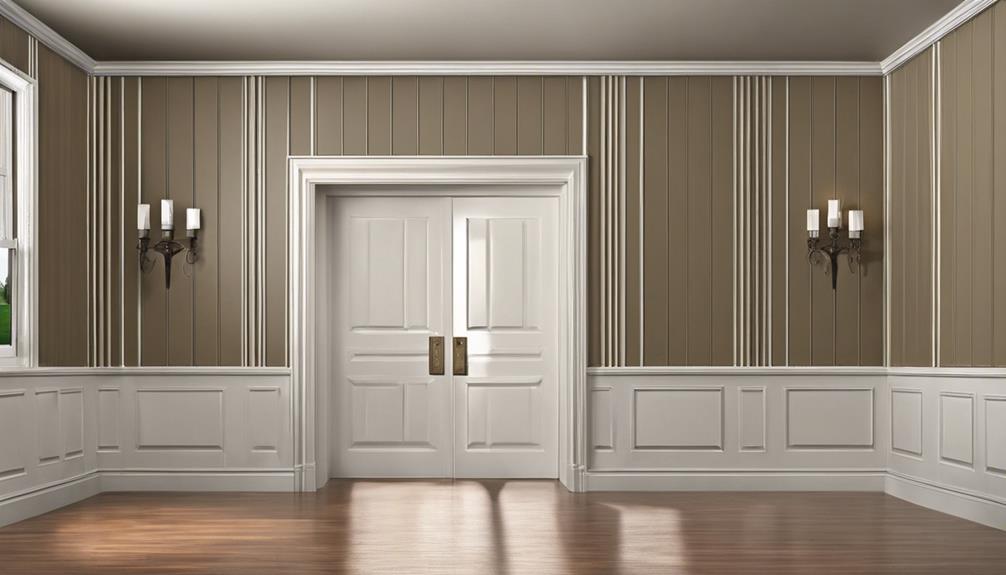
Let's transform your plain walls into a sophisticated work of art by creating a faux wainscoting effect using simple materials and clever techniques.
Faux wainscoting involves adding decorative panels or molding to walls to achieve a classic and elegant look. By incorporating elements like chair rail molding and painted panels, you can effortlessly create the illusion of traditional wainscoting without the hefty price tag.
Opting for budget-friendly materials such as MDF or trim allows you to enhance your walls with architectural interest and visual appeal, breaking away from the monotony of flat surfaces. This DIY trick not only revitalizes your space but also offers a versatile option that can be personalized to complement various design styles.
Experiment with different heights, colors, and patterns to tailor the faux wainscoting to suit your aesthetic preferences and elevate the sophistication of your home decor effortlessly.
Hang Statement Mirrors
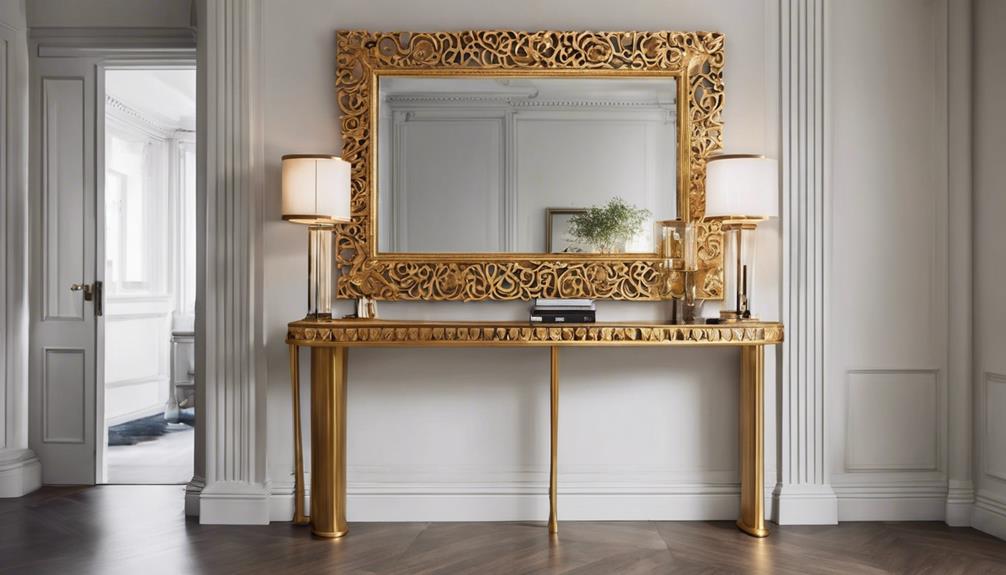
Let's talk about how statement mirrors can transform a dull space into a vibrant one.
The size of the mirror can dramatically impact the perception of the room, creating an illusion of spaciousness.
Placing mirrors strategically to reflect light can open up the area and choosing frames that match your style can add flair and depth to the space.
Mirror Size Matters
For a quick and effective way to add depth and style to your flat living space, consider hanging a statement mirror that complements your furniture and reflects natural light. When it comes to mirror size, opting for a larger one can create the illusion of depth and add visual interest.
Here are some tips to guide you in choosing the right mirror size:
- Choose a mirror that's at least half the width of the furniture below it for a balanced look.
- Hanging a mirror opposite a window can reflect natural light, making the room feel brighter and more spacious.
- Consider a round or oval mirror to soften the lines of a flat-front house and add elegance.
- Use mirrors strategically to bounce light around the room, creating the illusion of a larger, more dynamic space.
Placement Is Key
To amplify the impact of statement mirrors in your living space, consider the strategic placement that can maximize light reflection and enhance the perceived size of the room.
When hanging statement mirrors, think about positioning them across from windows or light sources to bounce natural light throughout the room, creating a brighter and more spacious feel. Placing mirrors on walls perpendicular to each other can also give the illusion of depth, making your flat-front house appear larger and more dynamic.
Additionally, hanging mirrors in high-traffic areas like entryways or living rooms as focal points can draw attention away from the flat facade and add a touch of elegance. Experiment with different placements to see how mirrors can transform your space effortlessly.
Frame Style Selection
Selecting the perfect frame style for your statement mirrors can elevate the aesthetic appeal of your living space and bring a touch of sophistication to the room. When choosing frame styles for your mirrors, consider the following:
- Ornate and gilded frames exude elegance and luxury, perfect for a classic living room.
- Sleek and minimalist frames offer a modern touch, ideal for contemporary spaces.
- Vintage or distressed frames bring a sense of charm and character to your decor.
- Geometric or uniquely shaped frames add an artistic flair, making a bold statement in any room.
DIY Floating Shelves
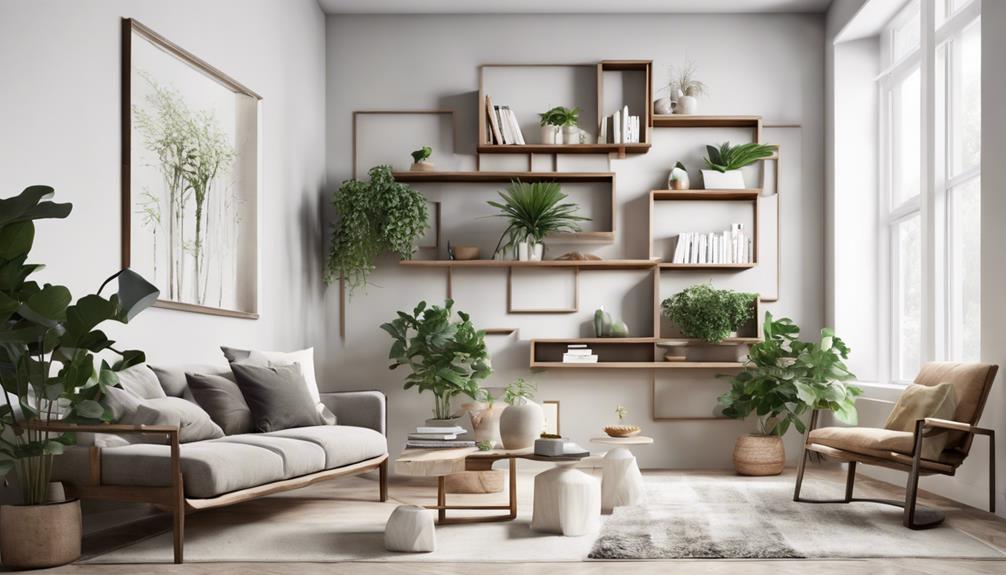
Crafting our own floating shelves allows us to effortlessly elevate the ambiance of our living spaces with a touch of contemporary flair. These shelves create a sleek and modern look by appearing to 'float' on the wall, bringing a minimalist and stylish element to any room. DIY floating shelves offer versatility, catering to various styles and sizes, making them a perfect fit for any space. With easy installation requiring minimal tools, they provide a budget-friendly storage solution that doesn't compromise on aesthetics.
Not only do floating shelves add a modern touch, but they also serve a practical purpose. They can be used to showcase decorative items, books, or plants, adding visual interest and personality to a room. By incorporating floating shelves, you can optimize storage and display opportunities without occupying valuable floor space. Embrace the trend of floating shelves to infuse your home with a contemporary vibe that's both functional and visually appealing.
Paint a Bold Accent Wall
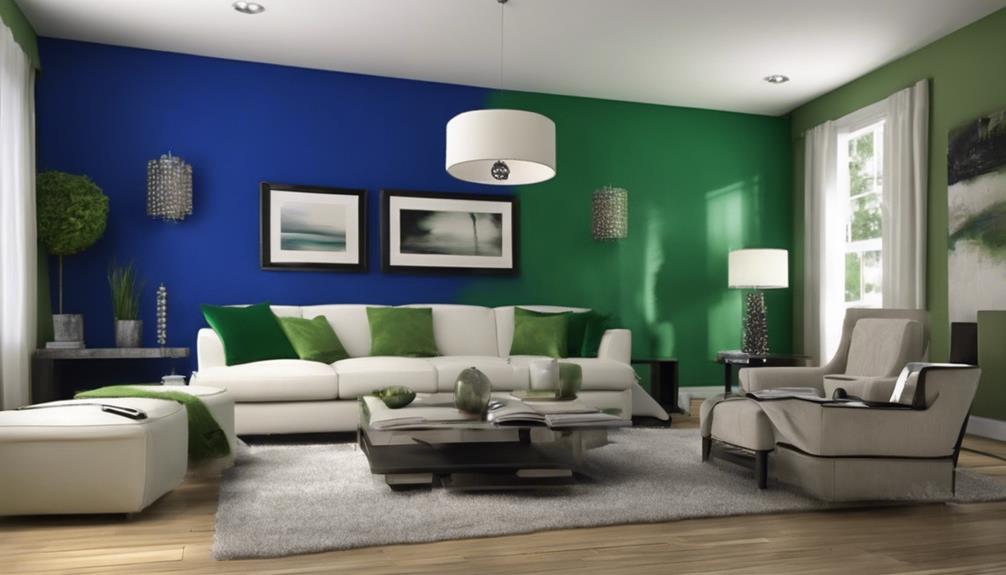
Elevating the modern aesthetic of your living space, consider painting a bold accent wall to add depth and create a striking focal point. When choosing a bold color for your accent wall, opt for a hue that contrasts with the rest of the room to make it pop.
Consider using wallpaper with a bold pattern to infuse your space with a unique and contemporary vibe. Painting an accent wall is a cost-effective way to transform a room without the commitment of a full paint job. Experiment with different textures like faux finishes or geometric designs to create a dynamic and visually appealing accent wall.
- Choose a bold color that contrasts with the room.
- Use wallpaper with a bold pattern for a modern look.
- Consider experimenting with different textures for added depth.
- Opt for geometric designs or faux finishes to create a striking accent wall.
Upgrade Light Fixtures
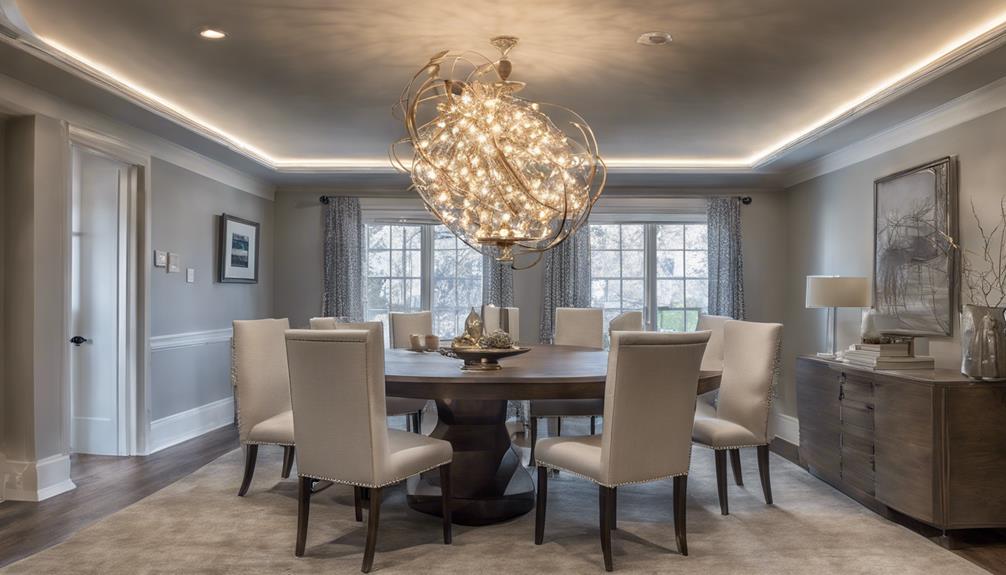
Looking to add a modern touch to your living space? Consider upgrading your light fixtures for a fresh and stylish ambiance. Installing modern pendant lighting can instantly give your room a contemporary flair. Upgrading pendant lights or lamps is a simple yet effective way to provide a fresh perspective to the room. With new light fixtures, you can update your space inexpensively while still achieving a significant impact. Trendy pendant lighting options are worth considering for a sleek and modern look. This cost-effective method of updating lighting fixtures can completely revamp the ambiance of a room without breaking the bank.
| Light Fixtures | Pendant Lighting |
|---|---|
| Modernize your space with sleek designs | Enhance the room's aesthetics |
| Create a contemporary ambiance | Provide ample lighting |
| Easy to install and customize | Energy-efficient options |
| Cost-effective upgrade | Versatile and stylish choices |
Incorporate Indoor Plants
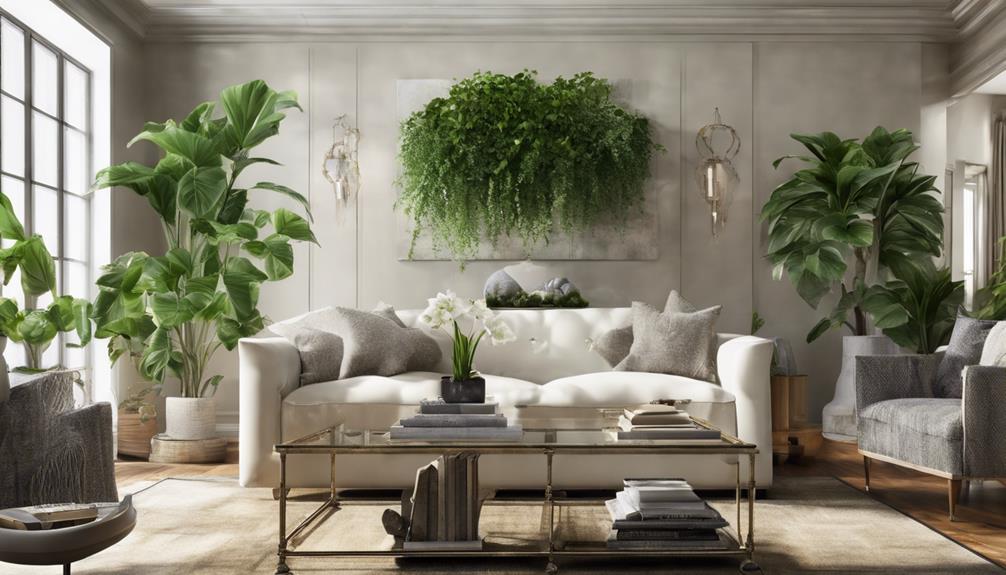
To infuse a breath of fresh air into your living space, consider incorporating indoor plants to add vibrancy and depth to your home decor. Indoor plants offer more than just visual appeal; they bring color, texture, and life to flat areas, transforming them into dynamic spaces.
Here are some creative ways to incorporate indoor plants:
- Opt for low-maintenance plants like snake plants, pothos, or peace lilies for easy care and a touch of greenery.
- Hang spider plants or ivy to draw the eye upward and create visual interest in rooms with flat ceilings.
- Choose a variety of plant sizes and types to fill empty spaces, adding depth and dimension to your home.
- Enjoy not only the aesthetic benefits but also improved air quality as indoor plants help reduce toxins and increase oxygen levels in your living environment.
With these indoor plants, you can effortlessly elevate your home decor while reaping the benefits of a greener, fresher living space.
Mix Textures With Throw Pillows
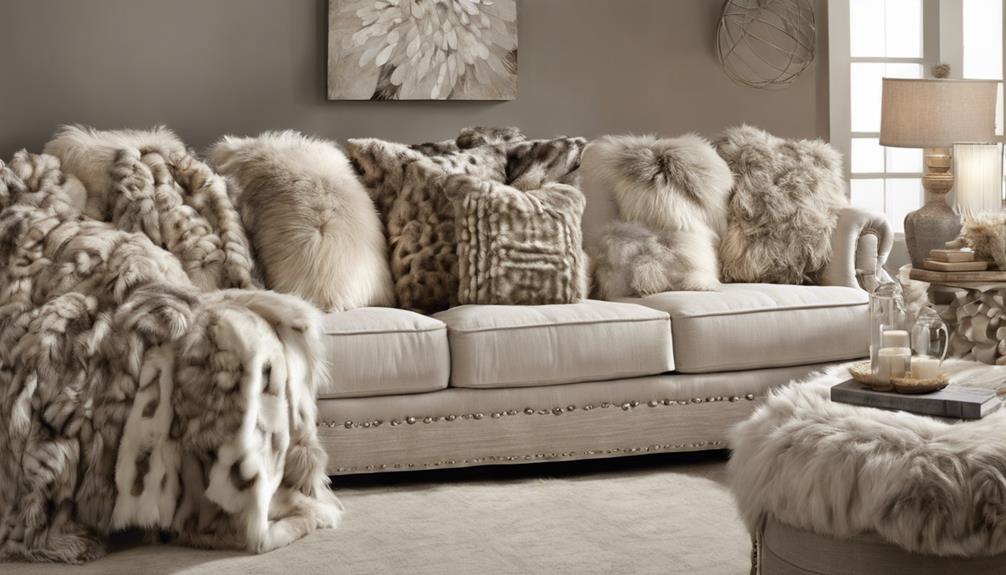
Mixing textures with throw pillows can effortlessly transform a room's decor from flat to invitingly dynamic. To create a custom look in your living space, consider incorporating Turkish rugs, silk, and velvet throw pillows.
By adding different textures like faux fur, knits, and embroidery, you can elevate the aesthetics of the room while infusing a personalized touch. These various materials not only add depth but also enhance visual interest, making the space more visually appealing.
Experimenting with different textures and patterns on throw pillows allows you to achieve a sophisticated and stylish look that reflects your unique style. Whether you choose to mix silk with velvet or faux fur with knits, the combination of textures will breathe new life into your living area, giving it a fresh and luxurious feel.
Frequently Asked Questions
How Do I Make My House Feel High End?
We create a high-end feel by incorporating neutral shades for an expensive and sophisticated look. Mimicking built-ins with DIY hacks adds luxury without the high cost.
Updating hardware like drawer pulls provides a cohesive and updated space. Installing a subway tile backsplash economically elevates the kitchen.
Mixing textures like Turkish rugs and velvet pillows gives a custom and upscale vibe. These tricks transform our house into a luxurious haven.
How Can I Make My Plain House Look Better?
We've discovered that adding just a touch of color to your plain house can boost its visual appeal exponentially. Consider incorporating vibrant shutters or a contrasting front door to catch the eye.
A pop of color can make a world of difference in making your home stand out in the neighborhood. Plus, it's a simple yet effective way to inject personality and charm into your otherwise plain facade.
How Can I Spruce up My House?
We can spruce up our house by incorporating various design elements that add depth and character. Enhancing the front steps, creating a welcoming walkway, and adding brick or flagstone textures can elevate the exterior appeal.
Professional landscaping with front gardens and curved beds can transform the flat facade into a visually appealing and inviting space. By combining these DIY tricks, we can significantly enhance the overall look of our home.
How Can I Decorate My House With Simple Things?
When looking to decorate our house with simple things, we often turn to nature-inspired elements like fresh flowers and plants. These additions bring life and vibrancy to our home effortlessly.
Incorporating decorative pillows and throw blankets can instantly inject color and texture into our living spaces.
Conclusion
As we put the finishing touches on our DIY projects, our once flat house now exudes warmth and character. The wallpaper accents add a touch of whimsy, while the statement mirrors reflect light and style throughout the space.
With upgraded hardware and light fixtures, our home feels cohesive and inviting. The indoor plants breathe life into every room, and the mix of textures in our throw pillows creates a cozy atmosphere.
Our house is no longer flat, but a vibrant reflection of our creativity and style.
- About the Author
- Latest Posts
Introducing Ron, the home decor aficionado at ByRetreat, whose passion for creating beautiful and inviting spaces is at the heart of his work. With his deep knowledge of home decor and his innate sense of style, Ron brings a wealth of expertise and a keen eye for detail to the ByRetreat team.
Ron’s love for home decor goes beyond aesthetics; he understands that our surroundings play a significant role in our overall well-being and productivity. With this in mind, Ron is dedicated to transforming remote workspaces into havens of comfort, functionality, and beauty.
Architecture Home Styles
How to Explore Native Houses in Indonesia
Catch a glimpse of Indonesia's cultural treasures through native houses, where each intricate detail holds a secret waiting to be discovered.

So, you think you've seen it all in Indonesia? Well, think again. Exploring native houses in this diverse archipelago offers a glimpse into a world where tradition meets craftsmanship in a harmonious blend.
From the intricate carvings to the unique architectural designs, each house tells a story waiting to be uncovered, inviting us to step into a realm where time seems to stand still.
But what lies beyond the façade of these cultural gems is a journey that promises to unravel the tapestry of Indonesia's rich heritage, revealing a side often overlooked by many travelers.
Key Takeaways
- Visit Batak, Toraja, and Joglo Houses for diverse architectural experiences.
- Discover intricate carvings and symbolic details in traditional Indonesian homes.
- Immerse in cultural heritage through communal spaces and ancient craftsmanship.
- Learn about Indonesia's rich history and values by exploring native houses.
Traditional Houses in Indonesia
In Indonesia, traditional houses embody rich cultural heritage through their unique architectural designs and symbolism. Among these remarkable dwellings, the boat-shaped houses stand out for their distinctive characteristics. The Batak House, found in certain regions, showcases intricate carvings and utilizes natural materials, reflecting a deep connection to the environment. These boat-shaped structures not only serve as homes but also as symbols of cultural identity and traditions passed down through generations.
The boat-shaped design of these traditional houses in Indonesia not only provides shelter but also represents a deeper meaning within the community. The intricate carvings on the Batak House, for example, tell stories of ancestry and spiritual beliefs, adding layers of significance to the architectural aesthetics. Through these boat-shaped dwellings, the indigenous peoples of Indonesia honor their heritage and preserve their cultural roots in a rapidly changing world.
Cultural Significance of Indigenous Dwellings

Exploring the intricate cultural significances embedded within indigenous dwellings in Indonesia unveils a tapestry of architectural symbolism and traditional values that resonate deeply within the communities they inhabit. These houses serve as more than mere shelters; they embody the cultural beliefs and practices of the diverse Indonesian tribes. The multi-generational living arrangements seen in houses like the Rumah Gadang in West Sumatra and the Rong Houses in Dayak communities highlight the importance of family and community ties in Indonesian society.
Moreover, the communal living spaces found in the Tongkonan House in Tana Toraja and the Uma Lulik in Timor foster a sense of togetherness and shared responsibilities among the inhabitants. Each architectural element, from the intricate carvings to the circular shapes and elevated stilts, holds deep symbolic meaning rooted in centuries-old traditions. These indigenous dwellings aren't just physical structures but living embodiments of Indonesia's rich cultural heritage, where every beam and wall tells a story of cultural continuity and communal harmony.
Top Native Houses to Visit
With intricate architectural designs and rich cultural symbolism, a journey to explore the top native houses in Indonesia promises a captivating immersion into the country's diverse heritage. Here are some of the top native houses you shouldn't miss:
| Native House | Features |
|---|---|
| Batak Houses | Boat-shaped roofs, intricate carvings, spaces for daily life activities like a living room and dining room. |
| Toraja Houses | Distinct saddleback roof design, used in ceremonies, areas for daily life such as a living room and dining room. |
| Joglo Houses | Elaborate wooden structures, symbolizing social hierarchy, with designated spaces for a living room and dining room. |
These native houses offer insights into the daily lives of the people inhabiting them. From the communal spaces like the living room where gatherings take place to the dining room where meals are shared, each house reflects the cultural practices and traditions of its respective community. Exploring these spaces provides a unique opportunity to understand the interconnectedness between architecture, daily life, and cultural identity in Indonesia.
Exploring Architectural Features
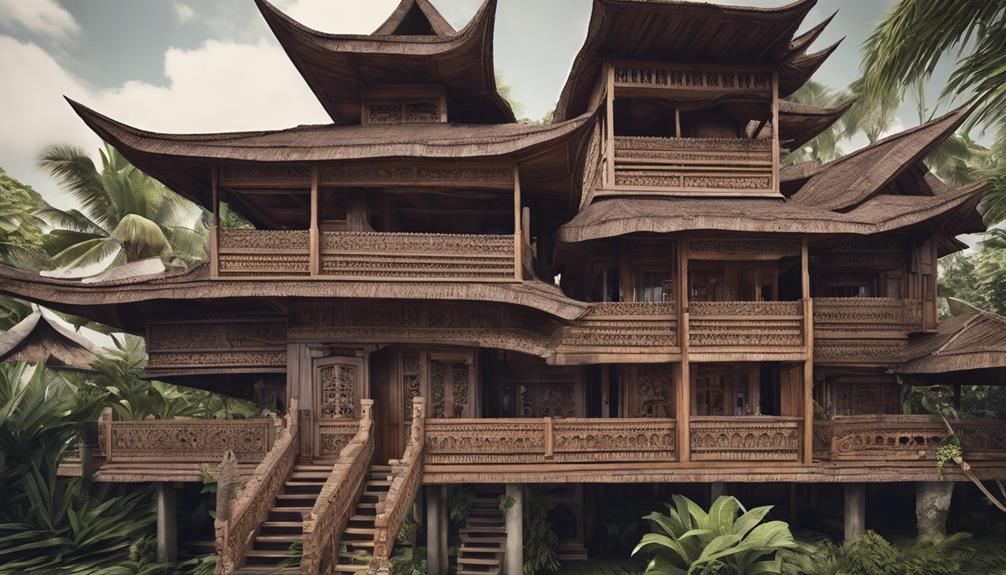
Amidst the vibrant tapestry of Indonesia's architectural landscape, one encounters a rich mosaic of cultural intricacies within the native houses that stand as living testaments to the country's diverse heritage. As we delve into exploring the architectural features of these remarkable dwellings, we're greeted by a fusion of craftsmanship and symbolism that captivates the senses:
- Boat-shaped roofs that gracefully mimic the curves of traditional Indonesian vessels, offering a nod to the nation's maritime history.
- Intricate carvings adorning the facades and interiors, telling stories of myths, legends, and ancestral wisdom.
- Wooden craftsmanship that showcases the mastery of artisans, each piece meticulously crafted to perfection.
- Natural materials seamlessly integrated into the structures, connecting the homes to the earth and reflecting a harmonious relationship with nature.
- Symbolic details embedded in every corner, from the layout to the decorations, embodying cultural beliefs and societal values passed down through generations.
Exploring these architectural marvels unveils a world where history, artistry, and tradition converge in a celebration of Indonesia's rich cultural heritage.
Immersing in Indonesian Hospitality
Immerse yourself in the captivating tapestry of traditional Indonesian hospitality by residing in native houses like the Batak House in North Sumatra or the Rumah Gadang in West Sumatra. These native houses not only offer a place to stay but also provide a gateway to the cultural heritage of Indonesia. The intricate carvings, boat-shaped roofs, and eco-friendly construction of these houses showcase the deep-rooted traditions and craftsmanship of the local communities.
Here is a table highlighting some of the unique aspects of traditional Indonesian hospitality found in native houses:
| Aspect | Description |
|---|---|
| Architectural Features | Intricate carvings, boat-shaped roofs |
| Social Significance | Symbolism of social hierarchy in houses like the Joglo House in Central Java |
| Eco-Friendly Construction | Use of sustainable materials like bamboo and thatch in houses like the Sasak House in Lombok |
| Spiritual Connections | Preservation of spiritual connections and communal living traditions in houses like the Uma Lulik in Timor or the Honai House in Papua |
| Local Way of Life | Experience the daily lives and customs of the local communities while staying in these native houses |
Staying in these native houses will not only provide you with a unique accommodation experience but also a deep dive into the rich tapestry of Indonesian traditions and hospitality.
Frequently Asked Questions
What Are Traditional Indonesian Houses Called?
Traditional Indonesian houses are called 'Rumah Adat.' These structures are more than just dwellings; they're living representations of Indonesia's rich cultural tapestry. Crafted from natural materials like wood and thatch, they stand as testaments to the country's diverse traditions.
Each region boasts its own unique design, influenced by local customs and beliefs. Exploring these native houses allows us to delve into the heart of Indonesia's vibrant heritage and architectural ingenuity.
What Is Indonesian Housing Like?
Indonesian housing embodies a rich tapestry of cultures and traditions, showcasing unique architecture and sustainable practices. From boat-shaped roofs to intricate carvings, these homes reflect a deep connection to nature and community.
Families often live together in multi-story structures, fostering bonds and kinship. Sustainability and cultural symbolism intertwine in Indonesian homes, creating a harmonious blend of functionality and heritage preservation.
Each dwelling tells a story of tradition, innovation, and unity.
What Is Typical Indonesian Housing?
We'll dive into the essence of typical Indonesian housing, showcasing the diverse array of styles like Batak, Toraja, Joglo, and more. These houses boast unique architectural features, reflecting the rich heritage of Indonesia's indigenous communities.
From intricate carvings to bamboo and thatch construction, each house tells a story of cultural significance and tradition. Multi-generational living arrangements further deepen the bond between people, highlighting the social and spiritual connections within the community.
What Is a House Called in Indonesia?
In Indonesia, a house is often referred to as a 'rumah' in Bahasa Indonesia. These structures aren't merely places of dwelling; they embody the essence of Indonesian culture and heritage.
Each region has its unique names for traditional houses, such as 'rumah adat' or 'rumah suku,' showcasing the diverse architectural styles and craftsmanship.
These homes serve as living monuments, reflecting the country's history, beliefs, and social structure.
Conclusion
In conclusion, exploring native houses in Indonesia is like taking a journey through a living museum of cultural heritage. Each traditional dwelling tells a story of the past and present, showcasing the craftsmanship and traditions of its people.
By immersing ourselves in these architectural wonders, we can truly appreciate the beauty and diversity of Indonesia's indigenous cultures. So, let's hit the road and dive into the rich tapestry of Indonesian history – the world is our oyster!
- About the Author
- Latest Posts
Introducing Ron, the home decor aficionado at ByRetreat, whose passion for creating beautiful and inviting spaces is at the heart of his work. With his deep knowledge of home decor and his innate sense of style, Ron brings a wealth of expertise and a keen eye for detail to the ByRetreat team.
Ron’s love for home decor goes beyond aesthetics; he understands that our surroundings play a significant role in our overall well-being and productivity. With this in mind, Ron is dedicated to transforming remote workspaces into havens of comfort, functionality, and beauty.
Architecture Home Styles
How to Have a Tiny Home in Arizona: Your Essential Guide
Fascinated by the idea of a tiny home in Arizona? Discover how tax considerations can impact your journey in this essential guide.
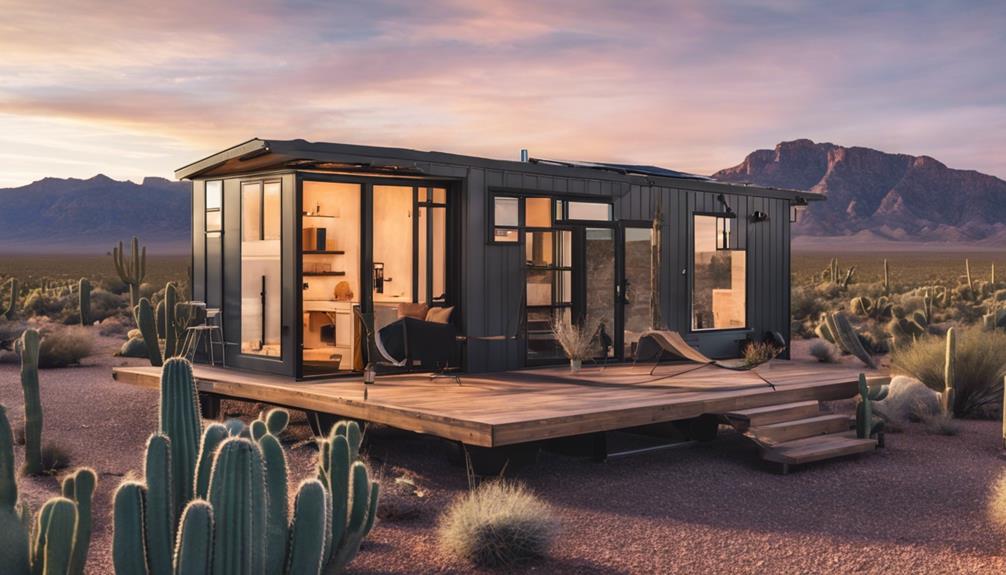
Embarking on the journey of having a tiny home in Arizona is like navigating through a desert oasis, each step revealing new insights and challenges. From understanding the intricate web of zoning laws to discovering the perfect location that aligns with your tiny living dreams, this essential guide equips you with the knowledge needed to turn your tiny home vision into reality.
But what about the unique tax considerations that come with owning a tiny home in Arizona? Stay tuned to uncover key insights that will make a difference in your tiny home journey.
Key Takeaways
- Understand Arizona zoning laws for placement in suitable zones.
- Seek permits for tiny homes based on location and structure type.
- Explore tax benefits for tiny homeowners through property tax exemptions.
- Build a supportive community through local groups and events for guidance.
Zoning Laws and Regulations in Arizona
When navigating the realm of tiny home living in Arizona, understanding the intricacies of zoning laws and regulations becomes paramount. In Arizona, zoning laws permit tiny houses on foundations in multifamily, detached single-family, and accessory dwelling unit zones.
However, for Tiny Homes on Wheels, they're typically classified as recreational vehicles and must adhere to specific parking regulations within designated zones. Maricopa County has established particular regulations for tiny houses, including constraints on the floor area allowed for permanent structures. On the other hand, Pima County imposes restrictions on Tiny Homes on Wheels through specific codes that govern their placement.
The zoning options for tiny houses in Arizona encompass various zones such as isolated single-family zones, accessory dwelling unit zones, and multifamily zones. Familiarizing oneself with these zoning laws and regulations is crucial for anyone considering embarking on the adventure of tiny home living in Arizona.
Ideal Locations for Tiny Homes
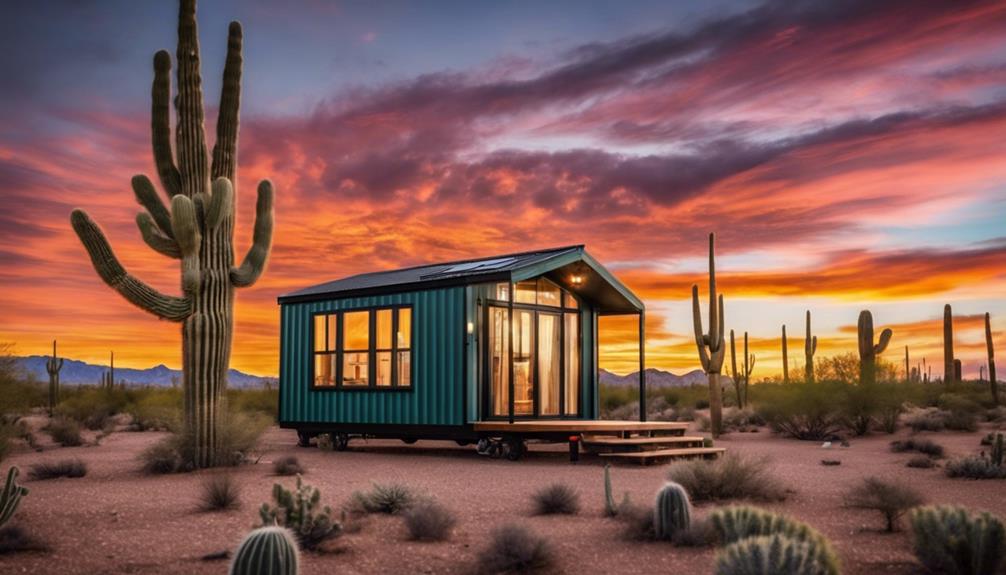
For those seeking ideal locations to establish their tiny homes in Arizona, cities like Phoenix, Tucson, Sedona, and Lakeside present attractive options. When considering where to set up your tiny home in Arizona, keep in mind that Pima County and Coconino County permit the establishment of tiny houses in specific zones. In these areas, tiny homes can be placed in isolated single-family zones, ADU zones, and multifamily zones. For those with tiny houses on wheels, it's important to note that they must be parked in designated R.V. zones in compliance with regulations.
- Phoenix, Tucson, Sedona, and Lakeside are ideal cities for setting up tiny homes in Arizona.
- Pima County and Coconino County allow tiny houses in specific zones.
- Tiny homes can be placed in single-family zones, ADU zones, and multifamily zones.
- Tiny houses on wheels must adhere to regulations in designated R.V. zones.
Tax Considerations for Tiny Home Owners
Exploring the tax implications of owning a tiny home in Arizona reveals potential benefits and considerations that can significantly impact financial planning for homeowners. Tiny home owners in Arizona may qualify for property tax exemptions based on factors like square footage and adherence to green building standards. Additionally, the size of tiny homes could lead to reduced property tax assessments in certain counties. It is crucial for Arizona tiny home owners to familiarize themselves with local tax laws to take advantage of any available tax benefits. Seeking guidance from a tax professional or local tax assessor can provide valuable insights into how owning a tiny home in Arizona may influence property taxes.
Tax Considerations for Tiny Home Owners:
| Key Points | Details | Importance |
|---|---|---|
| Property Tax Exemptions | Available based on square footage and green standards | Maximize Savings |
| Reduced Assessments | Smaller homes could mean lower tax bills | Financial Advantage |
| County Variances | Regulations differ, impacting tax benefits | Local Compliance |
| Professional Advice | Consult with tax professionals for guidance | Optimal Planning |
Finding Community Support in Arizona

By actively engaging with local resources and networking opportunities, tiny home enthusiasts in Arizona can establish a strong sense of community support to enhance their living experience.
Here are some ways to find community support in Arizona:
- Join local Facebook groups like 'Arizona Tiny House Community' for a supportive network.
- Attend tiny house meetups and events in Arizona to connect with like-minded individuals.
- Explore tiny house workshops and seminars in the state to gain knowledge and resources.
- Consider volunteering with non-profit organizations focused on sustainable living and tiny house advocacy in Arizona.
These opportunities not only provide a sense of belonging within the tiny house community but also offer valuable insights, resources, and support for those embracing the tiny home lifestyle in Arizona.
Engaging with these avenues can enrich your experience, foster connections, and empower you to navigate the challenges and joys of sustainable living in the state.
Building and Parking Tips for Tiny Homes
Engaging with the regulations and guidelines for building and parking tiny homes in Arizona is crucial for ensuring compliance and a smooth transition into sustainable living. Tiny homes on foundations in Arizona must adhere to the 2018 IRC Appendix Q requirements, which outline specific space dimensions and safety features to guarantee structural integrity.
Building a tiny home on skids offers a semi-permanent placement option while still allowing for mobility if relocation becomes necessary. For those opting for tiny homes on wheels, meeting mobile home requirements is essential, and a minimum of 160 square feet is required for parking.
The flexibility in setting up tiny homes in various zone types in Arizona provides diverse housing options based on individual preferences. Tiny houses on wheels are particularly popular for their mobility and flexibility, making them an attractive choice for those desiring a minimalist lifestyle without sacrificing comfort.
Frequently Asked Questions
Can I Put a Tiny House on My Property in Arizona?
Yes, we can put a tiny house on our property in Arizona if it complies with local zoning regulations. Different options like multifamily, detached single-family, or accessory dwelling units are available. Land near Maricopa City, Pinal County, offers accessible placement.
How Much Does a Tiny House Cost in Az?
Tiny houses in Arizona can range from $20,000 to $200,000 depending on size and customization. DIY kits start at $8,000, but labor costs add up. Land, utilities, and permits are extra. Building a tiny house can be a cost-effective housing choice.
What Is the Minimum Square Footage for a House in Arizona?
In Arizona, the minimum square footage for a house varies based on its foundation type. For tiny houses on foundations, it's 200 square feet, while those on trailers require at least 160 square feet. Adhering to building codes is essential.
Does Arizona Have a Tiny Home Community?
We do have tiny home communities in Arizona. These communities provide shared amenities, community engagement, and a supportive environment. Living in a tiny house community offers a unique sense of belonging, shared resources, and a close-knit experience.
Conclusion
In conclusion, navigating the world of tiny homes in Arizona may seem like a daunting task, but with the right resources and community support, it can be a breeze.
From zoning laws to building tips, we've covered it all in our essential guide.
So go ahead, take the leap into tiny home living and watch your dreams of a cozy, sustainable lifestyle come to life in the Grand Canyon State!
- About the Author
- Latest Posts
Introducing Ron, the home decor aficionado at ByRetreat, whose passion for creating beautiful and inviting spaces is at the heart of his work. With his deep knowledge of home decor and his innate sense of style, Ron brings a wealth of expertise and a keen eye for detail to the ByRetreat team.
Ron’s love for home decor goes beyond aesthetics; he understands that our surroundings play a significant role in our overall well-being and productivity. With this in mind, Ron is dedicated to transforming remote workspaces into havens of comfort, functionality, and beauty.
Architecture Home Styles
Exploring the Difference Between Traditional and Classic Design
Kickstart your journey into the world of design by uncovering the subtle yet significant distinctions between traditional and classic styles, shaping your perception of timeless elegance.
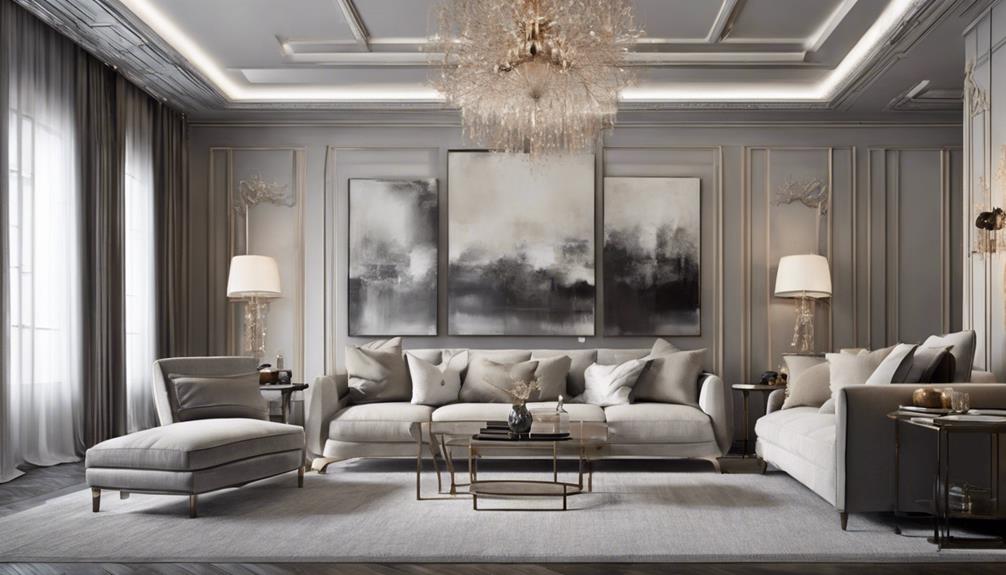
When considering traditional versus classic design, we uncover nuanced distinctions in style and aesthetic preferences. The interplay between historical influences and contemporary interpretations provides a fascinating insight into the evolution of design principles.
As we explore the intricate details and subtle nuances that set these two styles apart, it becomes evident that each offers a unique perspective on elegance and sophistication.
Stay tuned to unravel the intricacies that define the essence of traditional and classic design, shedding light on the nuances that shape our perception of timeless aesthetics.
Key Takeaways
- Traditional design features bold colors and intricate patterns, while classic design opts for soft and subdued colors for elegance.
- Both traditional and classic design styles focus on creating a balanced, inviting, and harmonious atmosphere.
- Traditional furniture embodies moderation and balance with solid wood, while classic furniture exudes nobility with gilded finishes.
- Lighting in traditional design aims for warmth and coziness, while classic design creates a luxurious ambiance with ornate fixtures.
Key Elements in Traditional Design
In traditional design, we intricately weave together elements of moderation, elegance, and balance to create a timeless aesthetic inspired by the rich European design traditions of the 18th and 19th centuries. Solid wood plays a pivotal role in this style, exuding warmth and coziness throughout the space. The choice of fabrics like cotton, leather, and velvet further enhances the comfort aspect, inviting you to sink into luxurious textures. Lighting is carefully curated to emanate a soft and inviting glow, achieved through the use of ambient sources such as table lamps and floor lamps, setting a cozy ambiance.
The color palette in traditional design is a symphony of rich colors like deep reds, lush greens, and vibrant yellows, adding depth and character to the space. These hues evoke a sense of opulence and sophistication, harmonizing beautifully with the overall design scheme. The blend of these elements creates a space that not only exudes elegance but also envelops you in a sense of comfort and luxury.
Characteristics of Classic Design
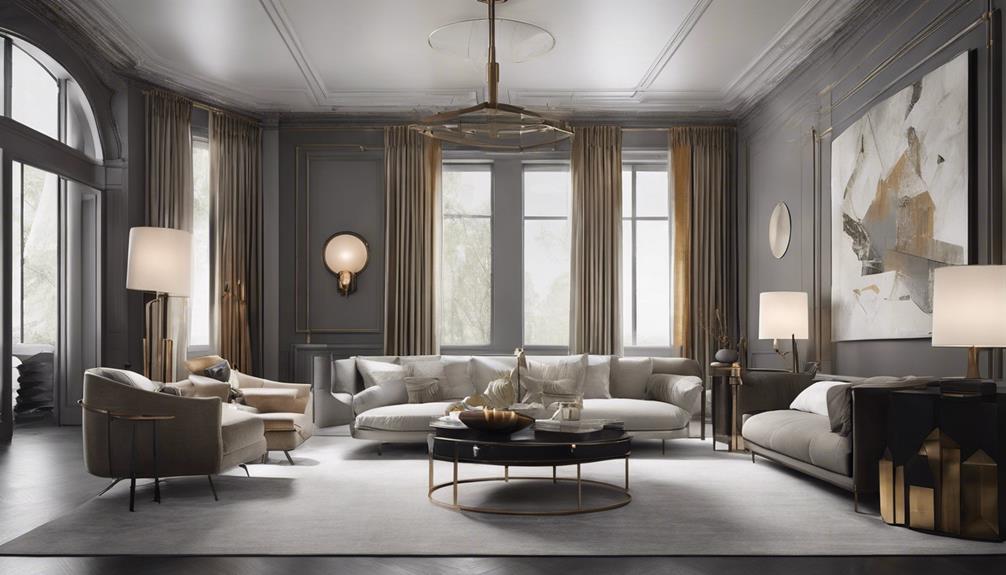
Transitioning from the rich tapestry of traditional design, classic design embodies a timeless allure through its emphasis on neutral hues, enduring furniture pieces, and ageless patterns. Classic design is about creating a space that feels elegant and sophisticated, never going out of style. This style incorporates traditional furniture pieces like wingback chairs and claw-foot tables, showcasing intricate details and a focus on symmetry. Antique or vintage items are often integrated into classic interiors to enhance the sense of heritage and history. Natural materials such as wood and marble play a significant role in classic design, adding a touch of authenticity and luxury. The use of neutral colors like beige, ivory, and taupe creates a serene and calming atmosphere, perfect for those who appreciate a refined aesthetic. Classic design is about capturing the essence of timeless beauty and creating a space that exudes grace and elegance.
| Characteristics | Description | Example |
|---|---|---|
| Neutral Colors | Create a serene atmosphere | Beige, Ivory, Taupe |
| Traditional Furniture | Emphasize heritage and sophistication | Wingback chairs, Claw-foot tables |
| Intricate Details | Showcase fine craftsmanship | Ornate carvings, Embossed patterns |
| Natural Materials | Add authenticity and luxury | Wood, Marble, Leather |
| Timeless Patterns | Enhance the sense of elegance | Damask, Toile, Houndstooth |
Color Palette Variances
Let's delve into the captivating interplay of colors in traditional and classic design, unveiling their distinct palettes and the emotions they evoke within interior spaces.
Traditional design is known for its bold use of color, incorporating rich tones like red, green, and yellow to create a lively and accented color palette. In contrast, classic design opts for a more subdued approach, favoring neutral and soft colors that convey timeless sophistication and elegance. Both styles share a common emphasis on proportion and harmony when selecting colors, ensuring a visually pleasing aesthetic within the space.
Classic design often showcases prestigious materials with subtle contrasts, exuding an air of understated luxury. On the other hand, traditional design tends to embrace vibrant colors and intricate patterns, adding a sense of energy and warmth to the room. The careful selection of color palettes in traditional and classic design plays a vital role in shaping the overall ambiance and character of the interior, showcasing a harmonious blend of elegance, proportion, and timeless sophistication.
Differences in Furniture Styles
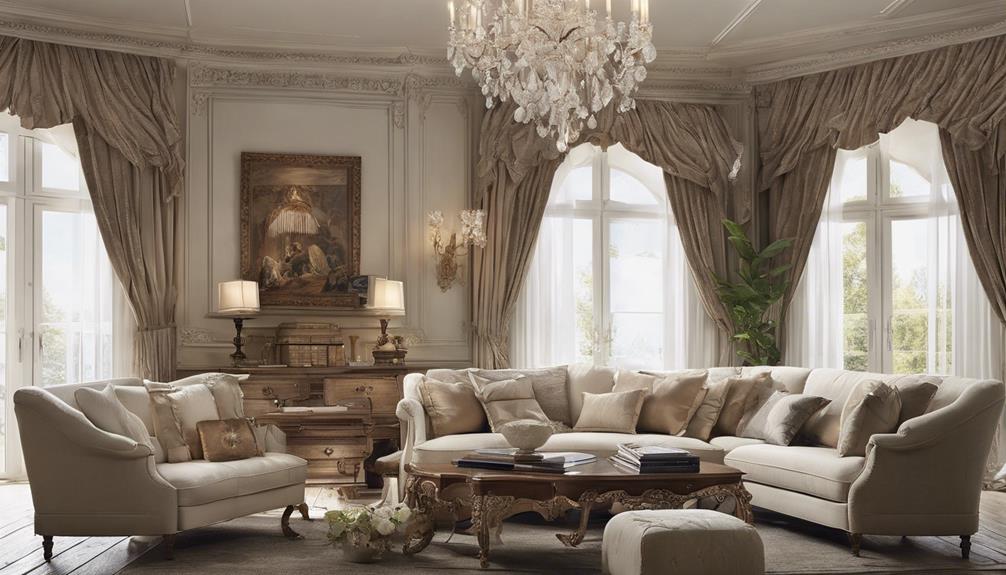
Embarking on a journey through the realm of interior design, we are met with a striking divergence in furniture styles between traditional and classic design aesthetics. Traditional furniture in European design, originating from the 18th and 19th centuries, embodies moderation, elegance, and balance. On the other hand, classic furniture exudes noble atmospheres with pomposity, showcasing prestigious materials like oak, mahogany, ceramic, marble, gold, and silver finishes.
| Traditional Furniture | Classic Furniture |
|---|---|
| Rooted in European design | Exudes ethereal nobility |
| Favoring moderation | Prestigious materials |
| Warmth and coziness | Gilded and opulent |
In traditional style, harmony is achieved through blending various elements, offering warmth and coziness with solid wood furniture and fabrics like cotton, leather, and velvet. In contrast, classic style features gilded finishes and gold leaf for a luxurious look, emphasizing richness and opulence. These styles also extend into lighting design, with traditional opting for warmer and softer lighting, creating a cozy feel with ambient lighting solutions like table lamps and floor lamps, while classic style leans towards ornate chandeliers and sconces for a grandiose touch.
Lighting Design Variances
As we delve into the realm of lighting design variances, a captivating interplay emerges between classic and traditional interior styles, each illuminating spaces with unique charm and character. Classic design exudes richness and opulence through lighting fixtures like grand chandeliers and intricately detailed sconces. These ornate details in classic lighting fixtures create a luxurious ambiance, evoking a sense of grandeur and sophistication within a space.
On the other hand, traditional design takes a softer approach, opting for warmer and cozier lighting solutions such as table lamps and floor lamps. The emphasis in traditional design is on creating a welcoming and comfortable environment, where ambient lighting plays a pivotal role in setting the mood. This style aims to promote a sense of intimacy and relaxation, steering away from the grandiose nature of classic design.
Both classic and traditional design styles strive for elegant lighting options that not only serve a functional purpose but also enhance the overall ambiance of a room. Whether it's the opulence of classic chandeliers or the cozy feel of traditional table lamps, lighting design plays a crucial role in shaping the character of a space.
Frequently Asked Questions
How Is Traditional Design Different From Modern Design?
Traditional design differs from modern design in various aspects.
We see traditional design focusing on warmth and rich colors like red and green, while modern design emphasizes sleek lines and minimalism.
Traditional design incorporates natural materials like wood for a cozy atmosphere, whereas modern design utilizes innovative materials for a contemporary look.
The former favors classic furniture with intricate details, while the latter features unique furniture and cutting-edge designs.
What Is the Definition of Traditional Design?
When it comes to traditional design, it's like stepping into a cozy retreat filled with elegant charm. Rich colors like red, green, and yellow dance together, creating a lively palette.
Classic lines and solid wood furniture greet you warmly, while fabrics like cotton and velvet whisper comfort and luxury. It's a timeless style that wraps you in a familiar embrace, making every corner of your home feel like a cherished memory.
What Is the Difference Between Modern Design and Classic Design?
When it comes to modern design and classic design, the distinction lies in their contrasting aesthetics.
Modern design embodies sleek lines and cutting-edge materials, reflecting a contemporary and innovative vibe.
In contrast, classic design exudes elegance and timeless sophistication with its traditional furniture and luxurious details.
These two styles offer a unique blend of old-world charm and futuristic elements, catering to different tastes and preferences in the world of design.
What Is the Difference Between Modern and Classic Home Design?
When it comes to modern and classic home design, the distinction lies in their essence.
Modern design embodies innovation and creativity with sleek lines and cutting-edge materials, ideal for those seeking a contemporary aesthetic.
Classic design, on the other hand, exudes elegance and sophistication through timeless pieces and intricate details, appealing to those who value tradition and refinement in their living spaces.
These contrasting styles offer unique choices for expressing personal taste and style preferences.
How Does Traditional Design Differ from Classic Design in Terms of Aesthetics and Functionality?
Traditional design encompasses a more ornate and intricate aesthetic, while classic design focuses on simplicity and elegance. In terms of functionality, traditional design often prioritizes practicality, while classic design may incorporate more decorative elements. The main difference between modern design and traditional design lies in their approach to aesthetics and practicality.
Conclusion
As we wrap up our exploration of traditional and classic design, it's clear that these styles offer unique and distinct characteristics. From the cozy warmth of traditional design to the timeless elegance of classic design, each style brings its own charm and sophistication to any space.
Whether you prefer the rich colors and intricate details of traditional design or the opulent finishes and neutral palettes of classic design, there's no doubt that both styles can create a truly stunning and inviting atmosphere.
So, which style speaks to you?
- About the Author
- Latest Posts
Introducing Ron, the home decor aficionado at ByRetreat, whose passion for creating beautiful and inviting spaces is at the heart of his work. With his deep knowledge of home decor and his innate sense of style, Ron brings a wealth of expertise and a keen eye for detail to the ByRetreat team.
Ron’s love for home decor goes beyond aesthetics; he understands that our surroundings play a significant role in our overall well-being and productivity. With this in mind, Ron is dedicated to transforming remote workspaces into havens of comfort, functionality, and beauty.
-

 Retreat6 days ago
Retreat6 days agoDIY Aromatherapy Diffusers for a Spa-Like Atmosphere at Home
-

 Retreat2 weeks ago
Retreat2 weeks agoThe Profitability of Retreat Centers: A Financial Analysis
-

 Retreat1 week ago
Retreat1 week agoUnusual DIY Projects: Designing a Space Probe in Bitlife
-
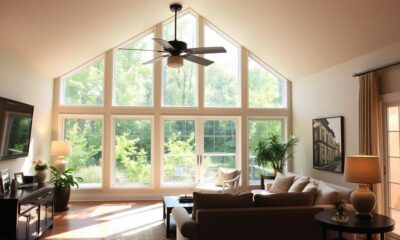
 Retreat2 weeks ago
Retreat2 weeks agoComprehensive Review: Are Home Decorators Ceiling Fans Worth the Investment?
-

 Retreat1 week ago
Retreat1 week agoIs Opening a Home Decor Store Profitable in 2024?
-

 Retreat1 week ago
Retreat1 week agoHow to Create a Zen Garden for Your Retreat Center
-

 Retreat2 weeks ago
Retreat2 weeks agoStep-By-Step Tutorial: Reupholstering a Chair With Buttons
-

 Retreat4 days ago
Retreat4 days agoThe Psychology of Color in Retreat Center Design











